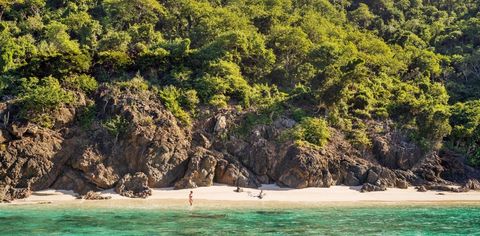
For nearly a century, Guana Island has drawn jet-setters seeking sun, solitude, and an ethos centred on the environment long before it was a trend. As the Caribbean slowly reopens, our contributor dips her toes in the balmy waters of this singular tropical retreat. Text by Heidi Mitchell; photographs by Jonathan Becker
Between us, my friend Camila and I own 26 headlamps. I know this because we tallied them as we stumbled in a race against the setting sun down Sugarloaf Mountain, the highest point on Guana Island—the dramatically lush British Virgin Island resort that seems practically flung into the Caribbean Sea. We cursed ourselves as we stepped through giant spiderwebs and danced around skull-size hermit crabs while the crescent moon became our only source of light. We cursed because all those headlamps we own remained back home in our camping kits. It never occurred to us to pack them. Who would have thought one could get lost in the dark on an 850-acre island whose highest peak is a mere 242 metres? And anyway, who would consider strapping on a headlamp at a resort where dressing up for dinner is de rigueur, and where Nobel laureates, prime ministers, and members of Hollywood royalty are your companions at the nightly cocktail hour?
We shouldn’t have worried about appearances, since it turned out none of those luminaries would be at our very, very private cocktail hours. In order to protect its 30,000 residents against the coronavirus, the British Virgin Islands closed the borders in March of 2020. Although the government reopened them in December, there were strict protocols in place when I visited in January, including proof of a negative test before arrival, and two tests once there—one upon landing, and another a few days later.
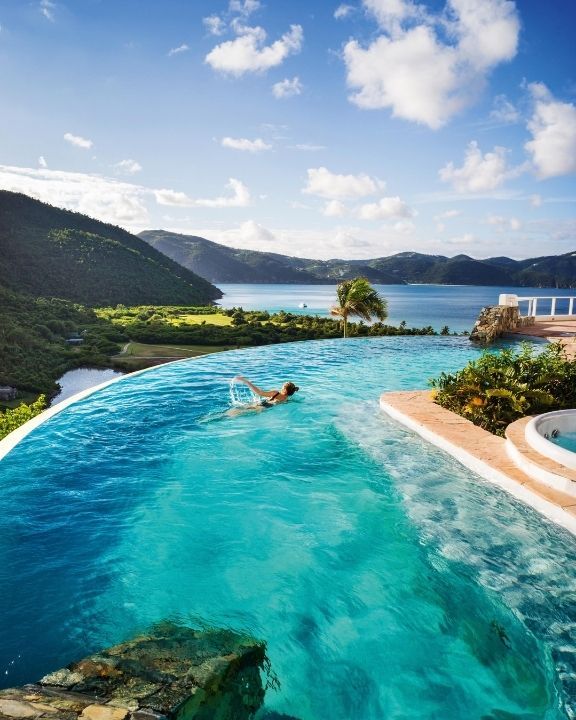
Travellers were starting to trickle back into Guana, among them an American tech billionaire, who, earlier in the season, had bought out the entire place for 30 of his luckiest friends. But for most of my week at the resort it was just Camila and me. We both needed an escape—Camila from her work as a frontline social worker in New York, and me from the brutal Chicago winter. I hadn’t set foot on a beach in ages, so while I came without my headlamps, I did arrive with a few modest goals: to swim daily; to spend quality time with my friend; and, after almost a year in lockdown, to finally take a moment to exhale.
Typically, the resort is sold out in January, with all 14 rooms and five villas taken over by “Guanaphiles” who stay every winter. Some regulars have been coming for three decades. Others are third-generation visitors, and the resort has an extraordinary 60 per cent rate of return. I got the sense that even at full occupancy, though, the feeling of privacy would remain strong.
Our first 24 hours were spent in quarantine, confined to our spacious compound and its surroundings—though this particular quarantine would have been the envy of anyone back home in snowy Chicago. We walked along our private beach and collected sea urchin and nautilus shells in absolute isolation. We swam in our own pool overlooking the crystalline sea, and I read up on the history of the place I’d be calling home for a week.

Guana is one of 16 inhabited islands among the roughly 40 that make up the British Virgin Islands. Archaeologists determined that ocean-faring, Arawakanspeaking Taino tribal groups were the first to arrive here from South America between 200 BCE and 100 CE, though there is some evidence that nomadic tribes from Venezuela set up fishing camps here as far back as 1500 BCE. In any case, all were displaced by the Caribs from the Lesser Antilles in the 14th century, who gave the surrounding sea its name and set up farms and fisheries as part of a thriving permanent settlement.
But in 1493, directionally challenged Christopher Columbus sailed into this archipelago and named his “discovery” Las Once Mil Vírgenes, after the legend of St Ursula and her 11,000 virgins. Columbus’s arrival meant the extermination of nearly all of the inhabitants. In the ensuing centuries, the rocky islands swapped ownership often, trading between the Dutch, the Spanish, and, eventually, the British. By 1773, the BVIs were granted semi-autonomous status; since 1967, the islands have had their own constitutional government, though they remain a territory of Great Britain.
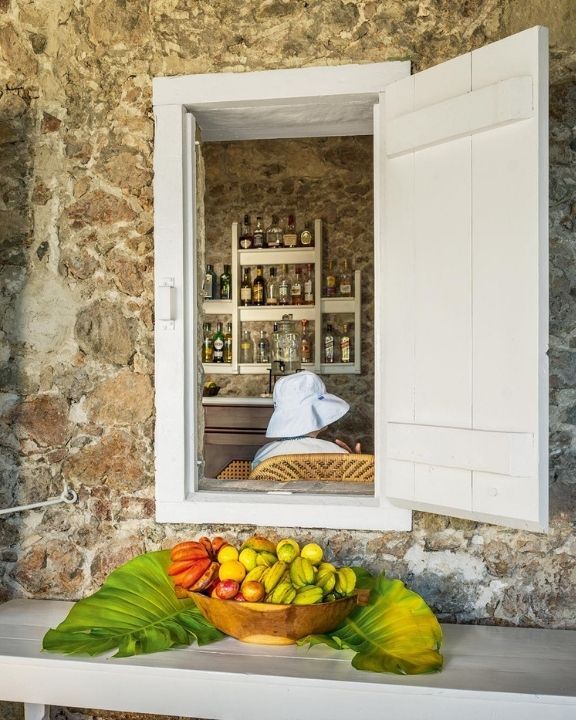
Guana itself was named after an iguana-shaped outcrop on its northwestern coast, I learned from the resort’s general manager, Jason du Plessis, as we chatted after a breakfast of omelettes made with eggs from the hundred or so chickens on the property. The island, he said, was “rediscovered” in the 18th century by two Quaker families from England, whose slaves cultivated cotton and sugarcane and processed those crops in what are now stone ruins that sit just above the salt pond.
Then, in 1935, a geologist and artist named Louis Bigelow and his wife, Beth, found themselves disillusioned with their commercialised lifestyle in post-industrialised Massachusetts, and ready to quit modern society. They bought the hilly island, pitched some tents, and invited their Boston Brahmin circle down to camp and swim. Their friends, mostly journalists and academics, eventually threw in some money to help build the low-slung Domenica Club, the hub of social activity (in normal times, anyway), and some small stone and coral cottages —all of which still stand today. The Bigelows spent the next four decades upgrading the facilities, dug a grass tennis court, and cleared several (quite treacherous) roads up and down the hills.

Guana got a taste of fame in 1958, when Pat Jackson made his film Virgin Island, starring Sidney Poitier and John Cassavetes on the island. For the next decade, the Hollywood crowd made the resort their hideaway. But with a capacity of only about two dozen guests, Guana stayed under the radar, and some 90 per cent of the island remained untamed.
That wildness appealed to New Haven–based Henry Jarecki, a psychiatrist and entrepreneur who escaped Nazi-occupied Poland, and his film-critic wife, Gloria. The couple had similar life goals to the Bigelows’, and had been schlepping their four boys around the globe in search of their own private paradise. After an initial visit, the Jareckis decided Guana Island was the place they’d been searching for. In 1975, the Bigelows moved back to the US and sold the island to the Jareckis, who set about elevating it to a proper bohemian resort.
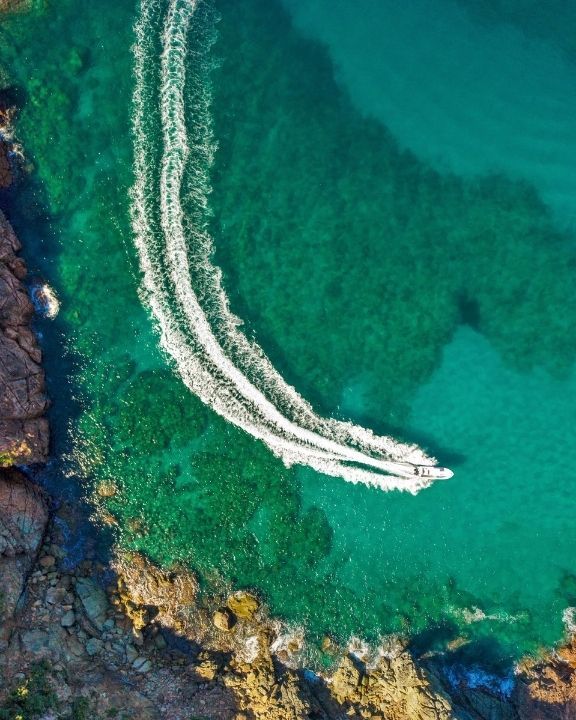
Meticulous caretakers to this day, the Jareckis have been inviting scientists to conduct surveys of the island’s flora, fauna, and marine life since the 1980s, spearheaded by Harvard zoologist James P Lazell, and have invested some $4 million (INR 298 million) in research alone. Meanwhile, gardener and ornithologist Liao Wei Ping took up permanent residence to design and care for a five-acre orchard, which now supplies the kitchen with a substantial amount of its produce. Despite the Jareckis’ love-hate relationship with nature—the 2017 hurricanes, Irma and Maria, decimated the island, requiring the resort to be almost completely rebuilt—the family remains committed to conservation. The coral reef beyond White Bay Beach is rebounding, along with its sea life. When Liao left a decade ago, he trained six full-time gardeners to take over the orchard, which now grows more than 81 species of fruits, vegetables, and spices, including breadfruit, mango, cashews, moringa, and at least five types of basil.
In fact, that orchard is what kept Guana, its owners, and its employees determined to stick it out during these challenging recent months. I spoke to Andrew Jarecki, one of the owners’ four sons, over Zoom while I quarantined. “My parents loved the idea of finding a hideaway that was fun but not commercialised,” he told me. “When they finally found Guana, only one family had really lived here before, and everything ran on a generator, which would shut off at 9.30 pm. Guests would swim and snorkel and fish all day, then return to their rooms to dress for dinner, and race back to get ready for bed before the power went out.”

Andrew was telling me all this as I tried not to get distracted. With the sliding glass doors open and the trade winds blowing through, I was mesmerised by the everchanging hue of the Caribbean, steps from where I sat. It was visual Xanax, and almost managed to erase the previous day’s 4.30 am wake-up call in Chicago, and the prop plane, and the nurse who administered my COVID test at the Tortola airport, mining my nostril so deeply she must have been hunting for brain matter.
Nevertheless, I focussed. Andrew is a natural storyteller—he won an Emmy for 2015’s The Jinx: The Life and Deaths of Robert Durst and an Oscar for 2003’s Capturing the Friedmans—and his passion for the island is clear. He told me how the family kept all 44 full-time staff members employed during the shutdown, which lasted from March to December. They were kept busy making thousands of meals with produce from the orchard, which were then delivered to residents of Tortola. And the team ensured that the Jarecki-funded Youth Empowerment Project (YEP)—opened in 2007 to provide tutors and a safe, free space for young people—remained open.
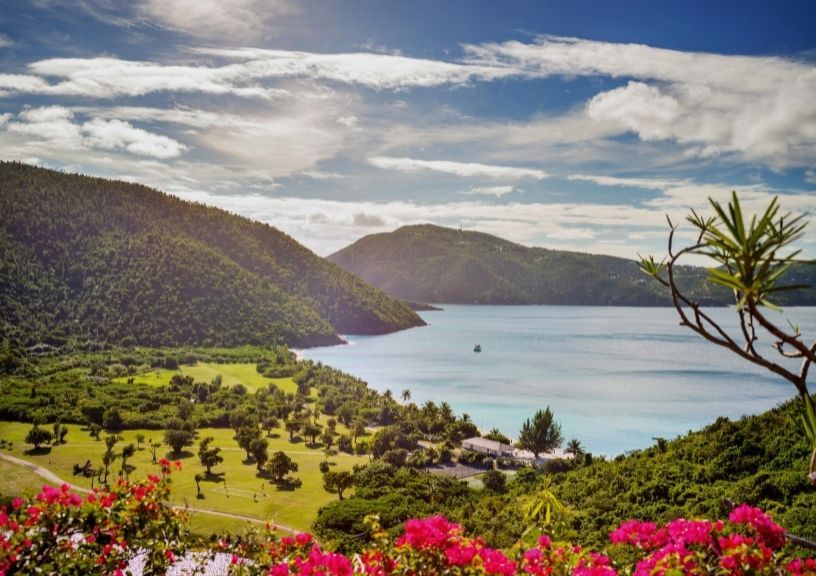
Now that Guana Island has at last reopened, Andrew believes the resort is ideally suited to travel in these strange times. “Social distancing is in our DNA,” he said, and he’s right. Camila and I were granted unlimited space and time to just vibe with all this wild beauty, to get up close and personal with the organ-pipe cacti that cling to the hillsides and the blooming frangipani that lines the pathways. Andrew gave me an itinerary: try to set foot on each of the seven beaches; eat freshly caught wahoo brought to the dock by a local fisherman; ask Chef Kael Mendoza to make a jerk-chicken roti; hike to Monkey Point; and, once my second test came back negative, get a massage. It was a packed schedule, I told him, but I’d try.
As soon as we got our first negative COVID test results, Camila and I set out for adventure. The next day, shaken but not broken by the Sugarloaf mishap, we hit the trailhead for Monkey Point. “Just park at the end of the orchard, and turn right. You can’t get lost,” du Plessis had told us. Oh, but we could. When we rappelled down a rope to the sea, thighs searing, we texted du Plessis and asked him to pick us up by boat, please. He couldn’t. The swells were too high. Also, we were not at Monkey Point, we were on Bigelow Beach. By then we’d given up on the reward of snorkelling, and didn’t want to miss one of Chef Kael’s soups (sunchoke! corn!) or the pink sunset, so we reluctantly hiked back up the slope to reach our golf cart. The iguanas rolled their eyes as we raced to dinner.
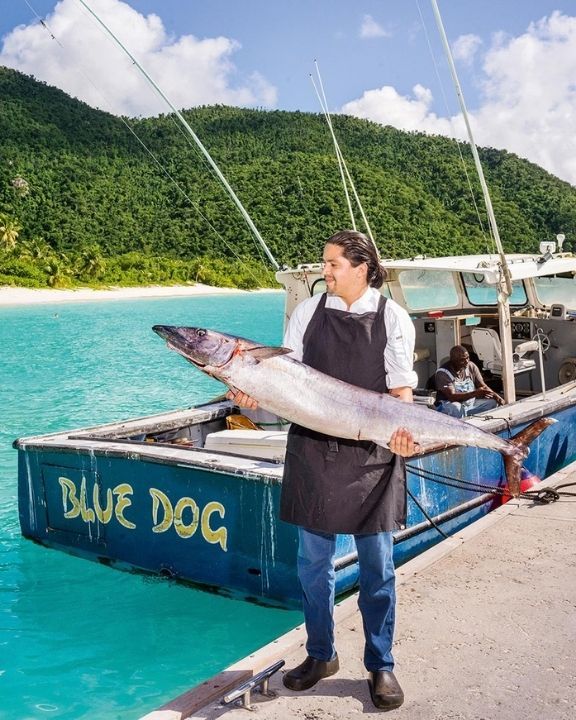
We didn’t actually have to get so physical, because there were so many other, less demanding things to do. There was day drinking at White Bay Beach. There were the three books I’d optimistically packed. There was Chef Kael’s orchard tour, where he served fresh papaya and coconut juice. There was outdoor movie night and massages in the cedar-roof spa. Once I got that second negative test result, I could technically explore all of the BVIs, including the famous bars and yachting marinas on Jost Van Dyke. But why would I leave Guana? I escorted Camila to the dock for her boat ride back to Tortola en route home to New York, but I didn’t go with her to check out the town. I had so much left to explore. And—for the first time in nearly a year—I could freely interact with strangers.
Assistant manager Nicole Laurac engaged me in a deep conversation about spirituality and raising kids. The guest manager, Jo Warren-Smith, earnestly described what it’s like living full-time on the island. I made overtures to the couple I spied out of quarantine, and blessed be, they invited me to dinner! So I washed my hair, zipped into a dress, and pretended I was going to meet previous guests like Rachel Weisz and Senator Patrick Leahy, whom a Guanaphile had told me she encountered on one of her 17 visits.

Dinner with this couple from the Poconos was filled with laughter and oversharing and Instagram-worthy food porn (my favourite dish: papaya gazpacho served in the actual fruit). We invited Laurac to join us, and after dinner took turns shaking martinis at the honuor bar. I promised to send Laurac images of Chicago snow via WhatsApp, which of course I did. Daily.
Over drinks, Laurac explained the island ritual of dropping a hyacinth into the waves as your boat sails away for the airport. Legend has it that, if it comes back to shore, you’ll return. After seven days, it was my time to try it. I closed my eyes and squeezed my flower and imagined a week with my kids and 30 other strangers, all family by day three, waking with the sun and sleeping to the sound of the waves. I pictured playing Bananagrams in the wicker chairs at the Domenica Club, swimming to the dock as the giant tortoises bobbed in White Bay, discussing politics in hammocks with a US senator. I made a mental note to pack at least one headlamp next time, and a compass. Then I tossed my ruby-red hyacinth into the water. As soon as I was back on dry land, I texted Laurac to make sure she retrieved it.
Getting There
United Airlines has flights from Mumbai and Delhi to Tortola with stopovers in Newark and San Juan. It’s then a five-minute ferry ride to Guana. For now, anyone arriving must show proof of a negative COVID PCR test, taken within 72 hours of departure; guests are tested again upon arrival and once more during their stay. Doubles from INR 67,786, all-inclusive.
Related: 15 Mistakes To Avoid On Your Next Caribbean Vacation










